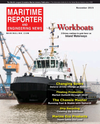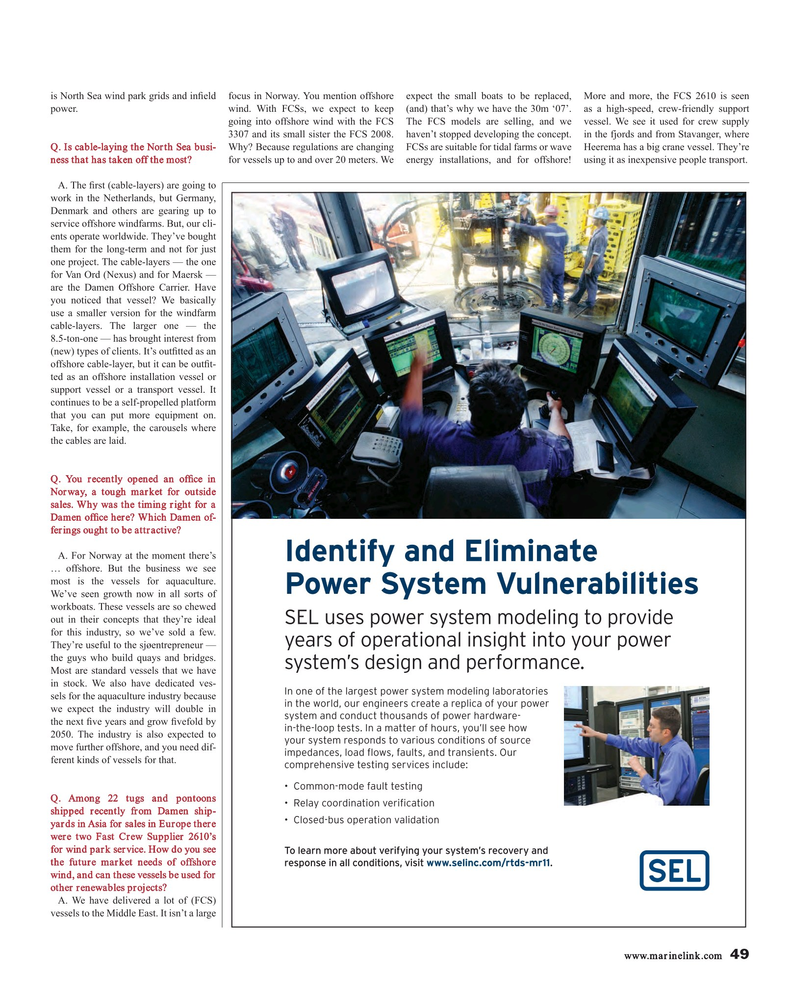
Page 49: of Maritime Reporter Magazine (November 2015)
Workboat Edition
Read this page in Pdf, Flash or Html5 edition of November 2015 Maritime Reporter Magazine
is North Sea wind park grids and in? eld focus in Norway. You mention offshore expect the small boats to be replaced, More and more, the FCS 2610 is seen power. wind. With FCSs, we expect to keep (and) that’s why we have the 30m ‘07’. as a high-speed, crew-friendly support going into offshore wind with the FCS The FCS models are selling, and we vessel. We see it used for crew supply 3307 and its small sister the FCS 2008. haven’t stopped developing the concept. in the fjords and from Stavanger, where
Q. Is cable-laying the North Sea busi- Why? Because regulations are changing FCSs are suitable for tidal farms or wave Heerema has a big crane vessel. They’re ness that has taken off the most? for vessels up to and over 20 meters. We energy installations, and for offshore! using it as inexpensive people transport.
A. The ? rst (cable-layers) are going to work in the Netherlands, but Germany,
Denmark and others are gearing up to service offshore windfarms. But, our cli- ents operate worldwide. They’ve bought them for the long-term and not for just one project. The cable-layers — the one for Van Ord (Nexus) and for Maersk — are the Damen Offshore Carrier. Have you noticed that vessel? We basically use a smaller version for the windfarm cable-layers. The larger one — the 8.5-ton-one — has brought interest from (new) types of clients. It’s out? tted as an offshore cable-layer, but it can be out? t- ted as an offshore installation vessel or support vessel or a transport vessel. It continues to be a self-propelled platform that you can put more equipment on.
Take, for example, the carousels where the cables are laid.
Q. You recently opened an of? ce in
Norway, a tough market for outside sales. Why was the timing right for a
Damen of? ce here? Which Damen of- ferings ought to be attractive?
A. For Norway at the moment there’s
Identify and Eliminate … offshore. But the business we see most is the vessels for aquaculture.
Power System Vulnerabilities
We’ve seen growth now in all sorts of workboats. These vessels are so chewed out in their concepts that they’re ideal
SEL uses power system modeling to provide for this industry, so we’ve sold a few. years of operational insight into your power
They’re useful to the sjøentrepreneur — the guys who build quays and bridges. system’s design and performance.
Most are standard vessels that we have in stock. We also have dedicated ves-
In one of the largest power system modeling laboratories sels for the aquaculture industry because in the world, our engineers create a replica of your power we expect the industry will double in system and conduct thousands of power hardware- the next ? ve years and grow ? vefold by in-the-loop tests. In a matter of hours, you’ll see how 2050. The industry is also expected to your system responds to various conditions of source move further offshore, and you need dif- impedances, load ?ows, faults, and transients. Our ferent kinds of vessels for that. comprehensive testing services include: • Common-mode fault testing
Q. Among 22 tugs and pontoons • Relay coordination veri?cation shipped recently from Damen ship- • Closed-bus operation validation yards in Asia for sales in Europe there were two Fast Crew Supplier 2610’s for wind park service. How do you see
To learn more about verifying your system’s recovery and the future market needs of offshore response in all conditions, visit www.selinc.com/rtds-mr11.
wind, and can these vessels be used for other renewables projects?
A. We have delivered a lot of (FCS) vessels to the Middle East. It isn’t a large www.marinelink.com 49
MR #11 (42-49).indd 49 10/30/2015 10:51:32 AM

 48
48

 50
50
